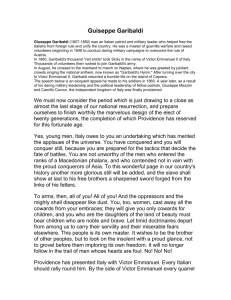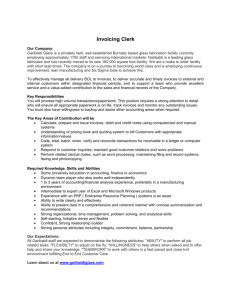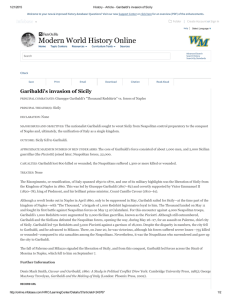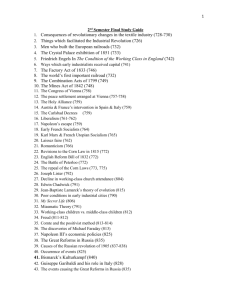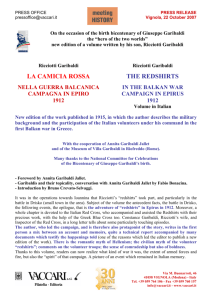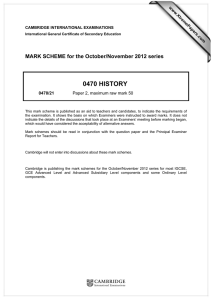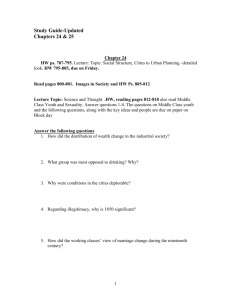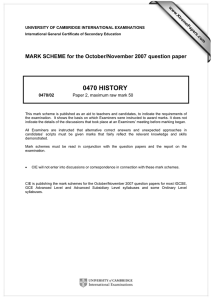www.XtremePapers.com
advertisement
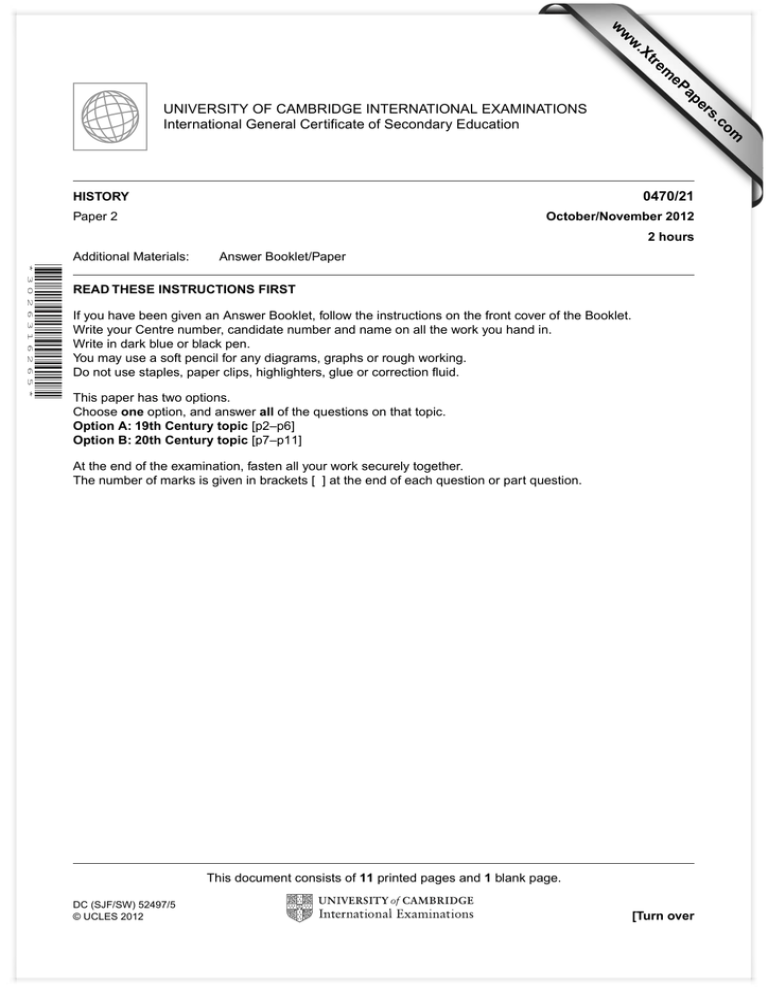
w w ap eP m e tr .X w om .c s er UNIVERSITY OF CAMBRIDGE INTERNATIONAL EXAMINATIONS International General Certificate of Secondary Education 0470/21 HISTORY Paper 2 October/November 2012 2 hours Additional Materials: Answer Booklet/Paper * 3 0 2 6 3 1 6 2 6 5 * READ THESE INSTRUCTIONS FIRST If you have been given an Answer Booklet, follow the instructions on the front cover of the Booklet. Write your Centre number, candidate number and name on all the work you hand in. Write in dark blue or black pen. You may use a soft pencil for any diagrams, graphs or rough working. Do not use staples, paper clips, highlighters, glue or correction fluid. This paper has two options. Choose one option, and answer all of the questions on that topic. Option A: 19th Century topic [p2–p6] Option B: 20th Century topic [p7–p11] At the end of the examination, fasten all your work securely together. The number of marks is given in brackets [ ] at the end of each question or part question. This document consists of 11 printed pages and 1 blank page. DC (SJF/SW) 52497/5 © UCLES 2012 [Turn over 2 Option A: 19th Century topic WAS GARIBALDI THE HERO OF ITALIAN UNIFICATION? Study the Background Information and the sources carefully, and then answer all the questions. Background Information Garibaldi has been seen by some as the hero of Italian unification. They argue that he and his ‘Thousand’ took the decisive action when, in 1860, they conquered Sicily from the Spanish Bourbons and then went on to invade and take control of Naples. In October, Garibaldi agreed to hand over his conquests to King Victor Emmanuel. In the same month, the people of Sicily and Naples voted to approve a new united Italy under Victor Emmanuel. However, there are others who have argued that Garibaldi nearly ruined the cause of unification. They claim that there were a number of reasons why Garibaldi could not win the support of all those working for Italian unification: he was after power for himself, he was too radical, and he was a supporter of the republican Mazzini. They also feared that Garibaldi wanted to conquer Rome, which would have alienated the French and stopped them from supporting Piedmont. Was Garibaldi really the hero of Italian unification, or was he often more of a hindrance and nuisance? SOURCE A There seems little doubt that Garibaldi’s image was manufactured and managed. Garibaldi and those around him worked hard to create a heroic image of him. Long before his death, control of Garibaldi’s image had become a powerful instrument of political propaganda, and this was because his popularity had reached fanatical levels. Garibaldi’s emergence as a popular hero coincided with a popular revolution in publishing and reading which made it possible to promote him on a huge scale. But how special was Garibaldi? I have argued that Garibaldi’s military ideas, and especially his vision of volunteering, were both original and popular, and that his military successes played a key role in his appeal. I have also suggested that the period of dictatorship in Sicily in 1860 was a more significant political experiment than is often assumed, and that his later political career contains much that is noteworthy. Historians have long struggled to distinguish between fact and fiction in the making of Garibaldi, to find the man behind the mask and to reveal the truth about his military failures, and his political mistakes. This is to completely miss the point about his life. The myth of Garibaldi may not be true, but it was effective. Garibaldi showed how Italians could be ‘made’, and his presence helped to create, encourage, and greatly increase support for political radicalism and nationalism. From a book published in 2007. © UCLES 2012 0470/21/O/N/12 3 SOURCE B Garibaldi’s great expedition of 1860 carried on the main work of Italian unity, at a time when no other method could have succeeded. The people in Sicily and Naples had proved incapable of bringing about a revolution in the face of an army of 90 000 men, without external help. Cavour was unable, owing to the attitude of France and Austria, to give that help. Nothing, therefore, could have liberated Sicily and Naples except a raid by volunteers of the revolutionary party, and no such raid could have succeeded except one led by Garibaldi. It was only the Garibaldian revolution in Sicily and Naples that put Cavour into the position from which he could have united the whole length of Italy into one state. This chain of reasoning establishes the supreme historical importance of Garibaldi’s expedition. The reputation of Garibaldi as a soldier depends on the history of 1859 and 1860, when he himself was at the height of his powers. In 1849, he had not yet fully adapted to the conditions of European warfare, and in his later campaigns he was old and lame. Some historians have judged him by his years of decline and decadence. But his ultimate place in history, not only as a soldier but as a patriot and magical leader of men, must depend on his great achievements in 1859 and 1860. From a book published in 1909. SOURCE C A British cartoon published on 16 June 1860. The sea monster represents the Bourbon monarchy. © UCLES 2012 0470/21/O/N/12 [Turn over 4 SOURCE D Garibaldi has become intoxicated by success and by the praise showered on him from all over Europe. He is planning the wildest schemes. As he remains devoted to King Victor Emmanuel, he will not help Mazzini or republicanism. But he feels it his duty to liberate all Italy, stage by stage, before turning her over to the King. He is thus putting off the day when Sicily will demand annexation to Piedmont, for he wants to keep the dictatorial powers which will enable him to raise an army to conquer first Naples, then Rome. We must prevent Garibaldi from conquering Naples, and we must try to annex Sicily as soon as possible. Were Garibaldi to become master of all the Neapolitan provinces, we would not be able to stop him from compromising us with France and Europe. If the Bourbons have to fall, it should not be by Garibaldi’s agency. Our annexation of Sicily will be a way of reducing his influence so that he ceases to be dangerous. Cavour in a letter to Nigra, his representative in Paris, 12 July 1860. SOURCE E In three weeks I have seen the extinction of Garibaldi’s popularity. The people who were wild with delight at the arrival of Garibaldi would now be equally delighted to get rid of him. The reasons for this change are obvious. His refusal to declare at once the annexation of Southern Italy to Piedmont has lost the support of the moderate party and generated suspicions of his intentions. A feeling has been created that he is dragging Naples on, not towards a peaceful union with the rest of Italy, but towards anarchy and war. Many of the laws issued by him go beyond the limits of temporary power. Add to this the bullying by many of Garibaldi’s officers. From the diary of an English tourist in Naples in September 1860. SOURCE F 10 September, 1860 Today I managed to get quite close and hear him speak. He is quite admirable, like a lion, with a firm voice, thick-set body and limbs. He must be terrible when angry, but in repose his eyes are quiet and his smile soft. More than a genius, he is a saint, a man of faith, strength and fearlessness, a miracleworker. To the poor, Garibaldi was a saint sent by God to deliver them. Neapolitans think that he is invulnerable, that he has only to shake his red shirt and bullets will fall harmless at his feet. 24 October, 1860 Garibaldi arrived early to vote for his King in the town which he had conquered by force. Outside the crowd made such a noise that Garibaldi was forced to come out on the balcony and speak, finishing with the popular gesture with his finger which means ‘united Italy’. From the diary of a Swiss writer in Naples. © UCLES 2012 0470/21/O/N/12 5 SOURCE G A British cartoon published in November 1860. The title of the cartoon is ‘Right Leg in the boot at last’. Garibaldi is saying, ‘If it won’t go on sire, try a little gunpowder.’ SOURCE H In politics, as in military matters, his mind lacked a basic education. He rushed to conclusions without troubling his head about arguments. His crude notions of democracy, of communism, of being a citizen of the world, were jumbled together in his brain and jostled one another in helpless confusion. A description of Garibaldi from a British newspaper, published at the time of his death in June 1882. © UCLES 2012 0470/21/O/N/12 [Turn over 6 Now answer all the following questions. You may use any of the sources to help you answer the questions, in addition to those sources which you are told to use. In answering the questions you should use your knowledge of the topic to help you interpret and evaluate the sources. 1 Study Sources A and B. How far do these two sources agree? Explain your answer using details of the sources. 2 [7] Study Source C. Why was this source published in June 1860? Explain your answer using details of the source and your knowledge. [7] 3 Study Source D. Are you surprised by this source? Explain your answer using details of the source and your knowledge. [8] 4 Study Sources E and F. Does Source F make Source E wrong? Explain your answer using details of the sources and your knowledge. [8] 5 Study Source G. What is the message of this source? Explain your answer using details of the source and your knowledge. [8] 6 Study all the sources. Do these sources provide convincing evidence that Garibaldi was the hero of Italian unification? Use the sources to explain your answer. [12] © UCLES 2012 0470/21/O/N/12 7 Option B: 20th Century topic WHY DID THE SOVIET UNION INVADE CZECHOSLOVAKIA IN 1968? Study the Background Information and the sources carefully, and then answer all the questions. Background Information In 1968 unrest over economic failures and the failure to keep up with Western levels of living standards spread in parts of Eastern Europe. In March 1968 a student demonstration in Poland led to several days of rioting in the streets of Warsaw. The Communist leader managed to survive with the support of the Soviets. However, the main trouble was in Czechoslovakia. In January 1968, against the background of student demonstrations, Alexander Dubcek was appointed leader of the Czechoslovak government. Although some members of the government disagreed with him, he began to introduce economic and political reforms that became known as ‘the Prague Spring’. Other members of the Warsaw Pact became increasingly worried about these reforms and on 20 August 1968, half a million Soviet troops crossed the border into Czechoslovakia. Did the Soviet Union invade Czechoslovakia because of pressure from other Eastern European Communist countries, or were there other reasons? SOURCE A The Soviet decision to invade Czechoslovakia on 21 August 1968 was slow in coming and was only taken as a last resort. The crisis had been brewing since the spring and one explanation for Soviet slowness to make up their minds would be that the situation was new for everyone. What were the limits beyond which a socialist state could not go without ceasing to be socialist? The Czechs repeated again and again their loyalty to the Warsaw Pact. They were idealistic, they were convinced that they were contributing to the development of socialism. Socialism with a human face. Censorship was abolished and plans to re-examine the sentences passed on political undesirables forced those who felt threatened into active opposition to the ‘Prague Spring’. The Czechoslovak tragedy can be seen as a failure to communicate. Had the Soviets made clear the limits beyond which the Czechoslovaks could not go, then it is likely that the whole episode would never have occurred. It was the slow Soviet response to the developing situation that made the situation worse. The Soviets were reluctant invaders. From a book published in 1991. © UCLES 2012 0470/21/O/N/12 [Turn over 8 SOURCE B From very early in 1968, other Communist leaders in Eastern Europe were alarmed by developments in Czechoslovakia. It was clear to them that the growing freedom could be highly infectious. Indeed, it was not long before demonstrating Polish students shouted, ‘We want a Polish Dubcek!’ The first sustained pressure put on the Czechoslovak leadership came at a meeting with five member states of the Warsaw Pact in March 1968. The Soviet political and military leadership had been making plans for months for a possible military intervention in Czechoslovakia, but the leadership had still not taken a definite decision in July. At the beginning of that month Brezhnev and Kosygin still favoured intense pressure on Dubcek, whereas several others already favoured the use of force. The meeting in early August between the Czechoslovak leaders and the Soviet and East European leaders produced a compromise document. At the very time when this agreement was being reached, the Soviet leadership were sent a letter they had been asking for to justify an invasion. It was a request from the hard-line members of the Czechoslovak leadership calling for intervention. The final decision to launch an invasion was taken between 15 and 17 August. From a book published in 2009. SOURCE C A British cartoon published in March 1968. The figure on the left is President Johnson of the USA. At this time the USA was heavily involved in Vietnam. © UCLES 2012 0470/21/O/N/12 9 SOURCE D Each country’s leader had a thick file of clippings from the Czech press. With varying intensity, they attacked us for ‘losing control’ over our situation and permitting a diversity of opinion that, in their view, bordered on ‘counter-revolution’. Mixed in were the usual references to ‘outside threats to the socialist camp’. I noted that the harshest criticism came from Gomulka, with Ulbricht only a little less arrogant. Brezhnev put on the face of the worried parent. On the whole I felt they had accepted what I said with understanding and respected our sovereignty over our own internal development. From Dubcek’s autobiography entitled ‘Hope Dies Last’, published in 1993. He is describing a meeting of the Warsaw Pact in March 1968. Gomulka was the leader of Poland and Ulbricht was the leader of East Germany. SOURCE E The Czech plans for counter-revolution are obvious. There can be no further doubt about this matter. The counter-revolutionaries want to crush and eliminate the Marxist-Leninists. I don’t know, Comrade Kadar, why you cannot understand this. Don’t you realise the next blow from imperialism will take place in Hungary? We can already detect that imperialist centres are concentrating their work now on the Hungarian intelligentsia. From a speech by Ulbricht at a meeting of the Warsaw Pact in July 1968. Kadar was the leader of the Communist Party in Hungary. SOURCE F We are appealing to you, Soviet communists, the leading representatives of the Communist Party of the Soviet Union, with a request for you to lend support and assistance with all the means at your disposal. Only with your assistance can the Czechoslovak Socialist Republic be rescued from the imminent danger of counter-revolution. From a letter to Brezhnev from some members of the Czechoslovak leadership. It was sent early in August 1968. The existence of this letter was kept secret by the Soviet Union until 1992. © UCLES 2012 0470/21/O/N/12 [Turn over 10 SOURCE G A cartoon published in the USA in September 1968. The soldier is saying ‘She might have invaded Russia’. SOURCE H A poster pinned up in the streets in Czechoslovakia in August 1968. It shows Lenin, the leader of the Soviet Revolution in 1917, and a Soviet tank. © UCLES 2012 0470/21/O/N/12 11 Now answer all the following questions. You may use any of the sources to help you answer the questions, in addition to those sources which you are told to use. In answering the questions you should use your knowledge of the topic to help you interpret and evaluate the sources. 1 Study Sources A and B. How far do these two sources agree? Explain your answer using details of the sources. 2 [7] Study Source C. What is the message of this cartoon? Explain your answer using details of the source and your knowledge. [8] 3 Study Sources D and E. Does Source E make you trust Source D? Explain your answer using details of the sources and your knowledge. [8] 4 Study Source F. Are you surprised by this source? Explain your answer using details of the source and your knowledge. [7] 5 Study Sources G and H. How far would the artists of these two sources have agreed with each other? Explain your answer using details of the sources and your knowledge. [8] 6 Study all the sources. Do these sources provide convincing evidence that the Soviet Union invaded Czechoslovakia because of pressure from other Eastern European countries? Use the sources to explain your answer. [12] © UCLES 2012 0470/21/O/N/12 12 BLANK PAGE Copyright Acknowledgements: Option A Source A Option A Source C Option A Source D Option A Source G Option B Source A Option B Source B Option B Source C Option B Source D Option B Source G Option B Source H © Lucy Riall; Garibaldi, Invention of a Hero; Yale University Press; 2007. © Garibaldi to the Rescue; Punch. © D Mack Smith; The Making of Italy 1796-1866; Macmillan; 1988. © Right Leg in the boot at last; Punch; c.1865. © John Traynor; Europe 1890-1990; Nelson; 1991. © Archie Brown; The Rise and Fall of Communism; Bodley Head; 2009. © Michael Cummings; Daily Express; 18 March 1968. © A Dubcek; Hope Dies Last; Harper Collins; 1993. © She might have invaded Russia; Washington Post; 3 September 1968. © T Rea, J Wright; International Relations 1914-1995; Oxford University Press/Magnum; 1997. Permission to reproduce items where third-party owned material protected by copyright is included has been sought and cleared where possible. Every reasonable effort has been made by the publisher (UCLES) to trace copyright holders, but if any items requiring clearance have unwittingly been included, the publisher will be pleased to make amends at the earliest possible opportunity. University of Cambridge International Examinations is part of the Cambridge Assessment Group. Cambridge Assessment is the brand name of University of Cambridge Local Examinations Syndicate (UCLES), which is itself a department of the University of Cambridge. © UCLES 2012 0470/21/O/N/12
